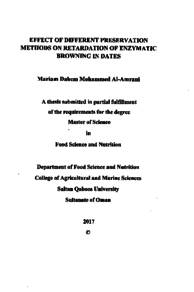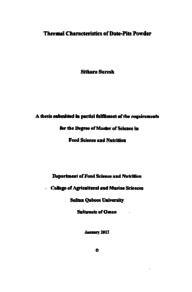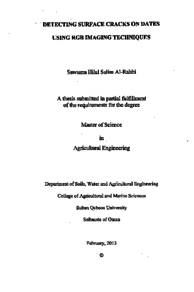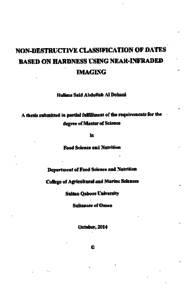Document
Effect of different preservation methods on retardation of enzymatic browning in dates
Publisher
Sultan Qaboos University
Gregorian
2017
Language
English
Subject
English abstract
Dates could be considered probably the most important fruit cultivar in the Middle East and especially Arab countries such as Oman. This fruit received abundant care from tanate government since it represents about 50% of the total agricultural land and 83% of fruit trees in the Sultanate. The fruit production in 2014 reached 316200 MT. The fruit is very nutritive as it is rich in many important nutrients and provide good source of rapidly available energy due to their high sugar content (70–80%). Dates' color is playing an important role in determination of date value and quality, Dates' darkening is a natural phenomenon which has adverse effect on the fruits color. The color changes from the natural accepted golden color to dark brown color. The change takes place at room temperature due to action of polyphenol oxidase and peroxidase enzymes and formation of melanin especially in tamer stage during storage. This defect causes loss up to 50%. on fruits and vegetables. In this project, the effect of different preservation methods on preserving the color and the relation between dark color and melanin pigment were investigated Dates samples were preserved by Modified Atmosphere Packaging (air was replaced by N2 gas), Cold Storage (4°C), Sulfur Dioxide gas, and blanching by steam (~100°C) for three minutes and one sample was kept as Control. After the treatment, the samples were stored for four months at room temperature; except the samples in the treatment Cold storage. During the storage, browning enzymes (polyphenol oxidase (PPO) and Peroxidase (POD)) activity, color, moisture content, water activity and melanin concentration were assessed in the treated samples as well as the control samples. The results showed that polyphenol oxidase (PPO) was active in all treatments except the samples treated with sulfur dioxide gas where no activity was noticed throughout the entire period of storage. On the other hand, peroxidase was found active in all samples where the sulfated samples had the lowest activity compared with the rest of the samples. Moreover, sulfated samples have shown improvement in color (lighter yellow color) compared with all other treatments, whereas, the steamed samples showed more color deterioration. Significant differences in water activity and moisture content were found between all treated dates (P value<0.05), the highest level was found in the steamed samples. Melanin content increased in all samples over the period of storage except in the sulfated samples. The results obtained from melanin measurements correlate positively with that obtained from color measurements. In conclusion, the obtained results demonstrate effectiveness of sulfation treatment to limit browning enzymes action and improve dates' color during storage at room temperature (25-27°C). Keywords: Polyphenol oxidase, Peroxidase, Melanin, Blanching, Dates, Sulfur Dioxide gas, Modified Atmosphere Packaging, Cold Storage.
Member of
Resource URL
Arabic abstract
تعتبر التمور من أهم أصناف الفواكه في الشرق الأوسط وخاصة الدول العربية مثل سلطنة عمان. تلقي هذه الفاكهة اهتمام خاص من حكومة سلطنة عمان كونها تمثل حوالي 50% من إجمالي الأراضي المزروعة و 83% من اشجار الفاكهة المثمرة في السلطنة حيث بلغ انتاج الفاكهة في عام 2014 ما مقداره 316200 طن متري. وللتمور قيمة غذائية عالية حيث انها غنية بالعديد من العناصر المغذية الهامة كما انها تعتبر مصدرا جيدا وسريعا للطاقة بسبب احتوائها على نسبة عالية من السكر البسيط (70-80%). يلعب لون ثمرة التمور دورا مهما في تحديد قيمته وجودته. ان اسمرار التمور هي ظاهرة طبيعية ذات تأثير سلبي على لون الفاكهة. في هذه الظاهرة يتغير اللون من اللون الذهبي الطبيعي المقبول إلى اللون البني الداكن. ويحدث هذا التغير في درجة حرارة الغرفة بسبب عمل الأنزيميات المسمره مثل البوليفينول أوكسيديز و البيروكسيديز وتكوين صبغة الميلانين خاصة في مرحلة التمر خلال فترة التخزين. وتعتبر هذه المشكلة مسؤوله عن خسائر اقتصادية كبيرة للفواكه والخضروات تصل إلى 50%. في هذا المشروع تم دراسة تأثير عدة طرق للحفظ في الحفاظ على اللون و العلاقة بين اللون الداكن وتركيز صبغة الميلانين في تمور الخلاص. الطرق التي تم استخدامها هي: تعديل بيئة الحفظ المحيطه، والتخزين المبرد، والمعالجة باستخدام غاز ثاني أكسيد الكبريت، والمعالجة باستخدام بخار ماء درجة حرارته - 100درجة مئوية لمدة ثلاث دقائق، وأبقيت عينة واحدة بدون معالجة للمقارنة. بعد المعالجة، تم تخزين العينات لمدة أربعة أشهر في درجة حرارة الغرفة باستثناء العينات المحفوظة في الثلاجة. وقد تم تقييم نشاط إنزيمات الأسمرار (بوليفينول أوكسيديز و بيروكسيديز)، وتغير اللون، ومحتوى الرطوبة والنشاط المائي وتركيز الميلانين خلال فترة التخزين. وأظهرت النتائج أن البوليفينول اوكسيديز كان نشطا في جميع المعالجات التي أجريت باستثناء العينات المعالجة باستخدام غاز ثاني أكسيد الكبريت حيث لم يلاحظ أي نشاط خلال فترة التخزين. من جهة أخرى، أظهرت النتائج وجود نشاط لأنزيم البيروكسيديز في جميع العينات. وعلاوة على ذلك، كان اللون الأصفر أعلى (افتح) في العينة المعالجة بغاز ثاني اكسيد الكبريت مقارنة مع جميع العينات الأخرى، وأقل مستوی وجد في العينات المعالجة ببخار الماء حيث أظهرت النتائج تدهور في اللون. كما أظهرت النتائج وجود اختلافات جوهرية في النشاط المائي ومحتوى الرطوبة بين جميع التمور المعالجة (-P 0 . 05> value)، وكانت أعلى المعدلات تمت ملاحظتها في العينات المعالجة ببخار الماء. كما تمت ملاحظة زيادة في محتوى الميلانين في جميع العينات طوال فترة التخزين باستثناء العينات المعالجة بغاز ثاني أكسيد الكبريت. ان النتائج التي تم الحصول عليها من قياس نسبة الميلانين أظهرت وجود علاقة طردية مع تلك التي تم الحصول عليها من قياسات اللون. وفي المجمل تشير النتائج التي تم الحصول عليها الى فعالية معالجة ثاني أكسيد الكبريت اللحد من عمل انزيمات الأسمرار و تمسين لون التمور خلال فترات التخزين في درجة حرارة الغرفة (25-27 درجة مئوية).
Category
Theses and Dissertations




